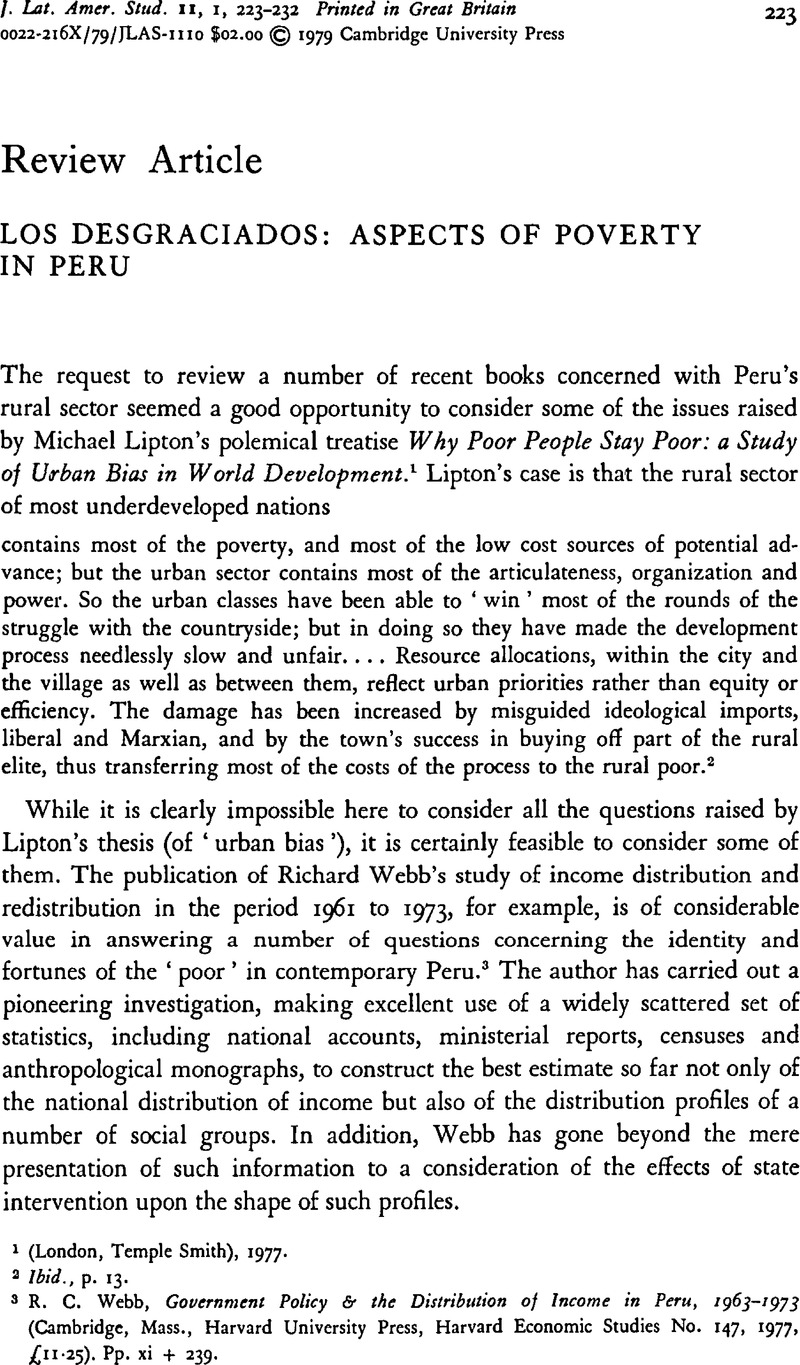No CrossRef data available.
Published online by Cambridge University Press: 05 February 2009

1 (London, Temple Smith), 1977Google Scholar.
2 Ibid., p. 13.
3 Webb, R. C., Government Policy & the Distribution of Income in Peru, 1963–1973 (Cambridge, Mass., Harvard University Press, Harvard Economic Studies No. 147, 1977, £11·25). Pp. xi + 239Google Scholar.
4 Ibid., pp. 13–14.
5 Ibid., p. 10.
6 Figueroa, A., ‘Income Distribution, Demand Structure and Employment: the Case of Peru’, Journal of Development Studies, 11, No. 2 (1975), p. 24.CrossRefGoogle Scholar
7 Hunt, S., ‘Real Wages and Economic Growth in Peru, 1900–1940’, Boston Center for Latin American Development Studies, Discussion Paper No. 25 (1977), p. 27Google Scholar.
8 Vendendries, R., ‘Income Distribution in Peru after World War II’, The Journal of Developing Areas, 8 (1974), pp. 421–36Google Scholar.
9 Cotler, J. & Portocarrero, F., ‘Peru: Peasant Organisations’, in Landsberger, H. (ed.), Latin American Peasant Movements (Ithaca, New York, Cornell University Press, 1969), p. 301Google Scholar.
10 Webb, op. cit., p. 38.Google Scholar
11 Ibid., p. 67.
12 Ibid., p. 97.
13 van den Berghe, P. L. & Primov, G. P., Inequality in the Peruvian Andes: class and ethnicity in Cuzco (Columbia, University of Missouri Press, 1977), p. 263Google Scholar.
14 See Piel, J., Capitalisme Agraire au Perou, Vol. I (Paris, Editions Anthropos, 1975)Google Scholar
15 Keith, R., Conquest and Agrarian Change: the Emergence of the Hacienda System on the Peruvian Coast (Cambridge, Mass., Harvard University Press. Harvard Historical Studies No. 93, 1976, £13·25). Pp. 176.Google Scholar
16 Ibid., p. 93–96.
17 Ibid., p. 106.
18 Eguren, F., Reforma Agraria, Cooperativización y Lucha Campesina: el valle Chancay-Huaral (Lima, DESCO, 1975), p. 16Google Scholar.
19 Horton, S. Ramírez, ‘The Sugar Estates of the Lambayeque Valley, 1670–1800: a Contribution to Peruvian Agrarian History’ (University of Wisconsin-Madison, Land Tenure Center), Research Paper No. 58, 1974, p. 9Google Scholar.
20 For an excellent examination of this process, see Albert, B., An Essay on the Peruvian Sugar Industry 1880–1920 (School of Social Studies, University of East Anglia, Norwich, 1976), pp. 333–643Google Scholar.
21 Webb, op. cit., p. 47, Table 4.2Google Scholar.
22 Ibid., p. 59.
23 Ibid., p. 87.
24 Bayer, D. L., Descapitalización del Minifundio y Formación de la burguesia rural (Lima, CISE, Universidad Nacional Agraria, La Molina, 1975, n.p.s.)Google Scholar.
25 Valderrama, M., 7 Años de Reforma Agraria Peruana, 1969–1976 (Lima, Pontifica Universidad Católica del Perú, 1976), p. 622Google Scholar.
26 I am indebted to José M. Caballero of the Universidad Católica del Peru, Lima, for these estimates.
27 For a detailed examination of this phenomenon, see Bell, W. S., ‘Unequal Redistribution: post agrarian reform differentiation in coastal Peru’(mimeo, 1977)Google Scholar.
28 Figueroa, A., ‘The Impact of current reforms in Peru’, in Foxley, A. (ed.), Income Distribution in Latin America (Cambridge, Cambridge University Press, 1976), pp. 168–71.Google Scholar
29 Chronicled in Valderrama, op. cit.
30 Martínez-Alier, J., Haciendas, Plantations and Collective Farms: Agrarian Class Societies - Cuba and Peru (London, Frank Cass, 1977, £8·50). Pp. viii + 185Google Scholar.
31 Ibem, p. 37.
32 Ibem, p. 55.
33 Ibem, p. 89.